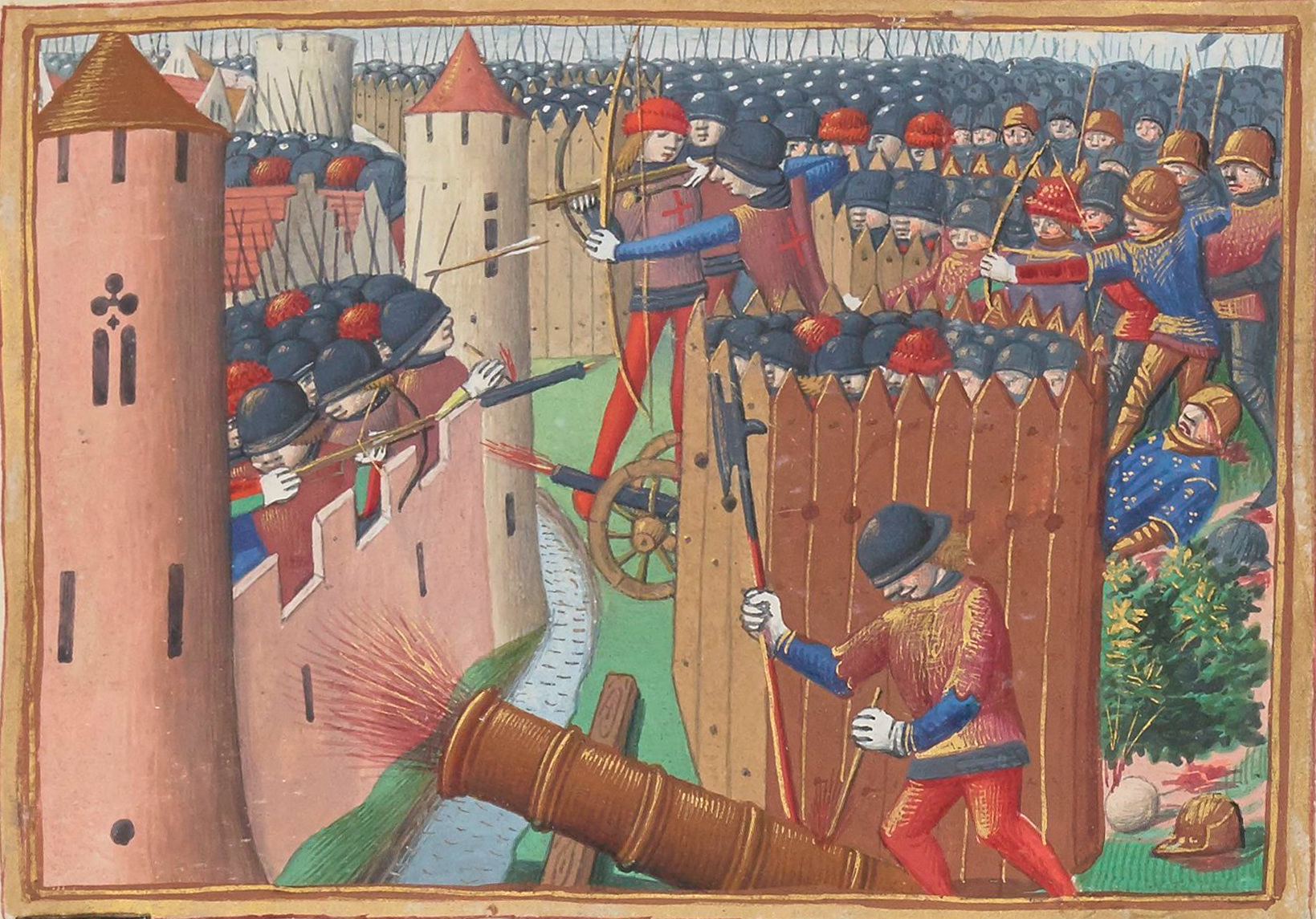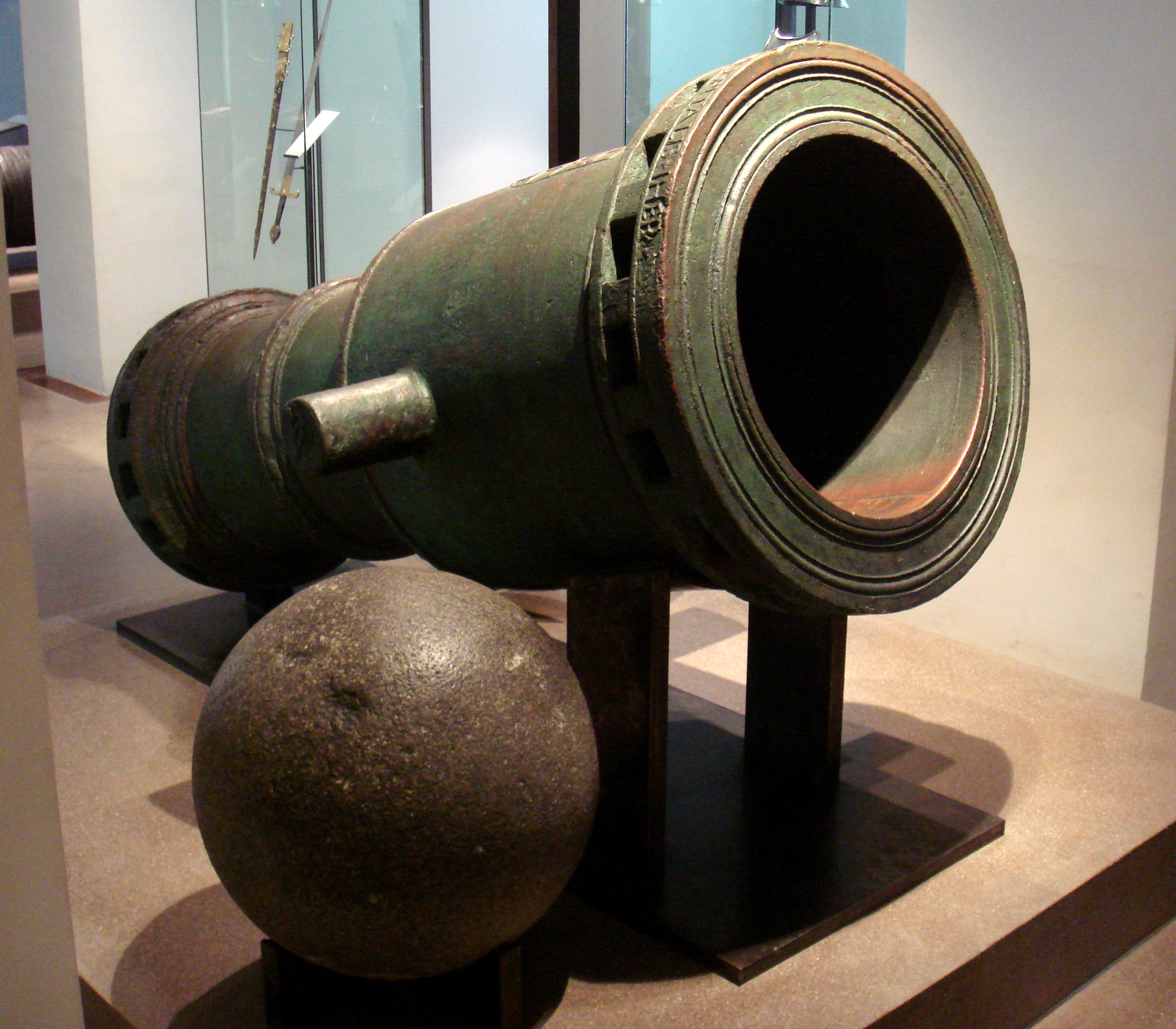|
Artillery Of France In The Middle Ages
Artillery began to be used in France in the 14th century. The first depiction of a cannon in Europe appeared in Walter de Milemete's 1326 ''De nobilitatibus, sapientiis, et prudentiis regum''. Small rudimentary weapons such as the pot-de-fer or the portable bâton à feu were introduced. At this early stage, cannon would fire either stone balls or metal pellets.John A. Wagner, ''Encyclopedia of the Hundred Years War'p.34/ref> 14th-century developments The 14th century saw considerable development of the new weapons in France and in Western Europe in general, especially with the outbreak of the Hundred Years' War (1337–1453). Cannons were soon used at sea, with ships being used as a firing platform. Small guns projecting quarrels or lead pellets were used at the 1340 Battle of Sluys, and in the French defence of Tournai in August 1340. Edward III used similar weapons at the Battle of Crécy in 1346, and in the Siege of Calais in 1347. "Ribaldis" were first mentioned in th ... [...More Info...] [...Related Items...] OR: [Wikipedia] [Google] [Baidu] |
Siege Orleans
A siege is a military blockade of a city, or fortress, with the intent of conquering by attrition, or a well-prepared assault. This derives from la, sedere, lit=to sit. Siege warfare is a form of constant, low-intensity conflict characterized by one party holding a strong, static, defensive position. Consequently, an opportunity for negotiation between combatants is common, as proximity and fluctuating advantage can encourage diplomacy. The art of conducting and resisting sieges is called siege warfare, siegecraft, or poliorcetics. A siege occurs when an attacker encounters a city or fortress that cannot be easily taken by a quick assault, and which refuses to surrender. Sieges involve surrounding the target to block the provision of supplies and the reinforcement or escape of troops (a tactic known as "investment"). This is typically coupled with attempts to reduce the fortifications by means of siege engines, artillery bombardment, mining (also known as sapping), or the u ... [...More Info...] [...Related Items...] OR: [Wikipedia] [Google] [Baidu] |
Wrought Iron
Wrought iron is an iron alloy with a very low carbon content (less than 0.08%) in contrast to that of cast iron (2.1% to 4%). It is a semi-fused mass of iron with fibrous slag Inclusion (mineral), inclusions (up to 2% by weight), which give it a wood-like "grain" that is visible when it is etched, rusted, or bent to structural failure, failure. Wrought iron is tough, malleable, ductile, corrosion resistant, and easily forge welding, forge welded, but is more difficult to welding, weld electrically. Before the development of effective methods of steelmaking and the availability of large quantities of steel, wrought iron was the most common form of malleable iron. It was given the name ''wrought'' because it was hammered, rolled, or otherwise worked while hot enough to expel molten slag. The modern functional equivalent of wrought iron is Carbon steel#Mild or low-carbon steel, mild steel, also called low-carbon steel. Neither wrought iron nor mild steel contain enough carbon to be ... [...More Info...] [...Related Items...] OR: [Wikipedia] [Google] [Baidu] |
Veuglaires
The Veuglaire (derived from the German ''Vogler'' and ''Vogelfänger'', and the Flemish ''Vogheler'', after a gun manufacturer named Vögler. English: Fowler) was a wrought iron cannon, and part of the artillery of France in the Middle Ages. There, guns were initially called , or . The ''Veuglaire'' was up to 2 meters (8 feet) long, and weighing from 150 kg to several tonnes, and compares to the '' Crapaudins'' or ''Crapaudaux'', which were shorter (4 to 8 feet) and lighter than the ''Veuglaires''. The ''Veuglaires'' were usually breech-loading, and therefore used a separate "powder chamber" (''boîte à poudre'') in which powder and ball were located upon loading, and the main body of the cannon was formed of a tube opened at both ends. ''Veuglaires'', together with ''Crapaudins'', were considered medium-sized weapons and tended to have smaller chambers than bombards. They belonged to a category of weapons developed from the late 14th century, which had smaller bore and ... [...More Info...] [...Related Items...] OR: [Wikipedia] [Google] [Baidu] |
Bracelet
A bracelet is an article of jewellery that is worn around the wrist. Bracelets may serve different uses, such as being worn as an ornament. When worn as ornaments, bracelets may have a wikt:supportive, supportive function to hold other items of decoration, such as Charm bracelet, charms. Medical and Body identification, identity information are marked on some bracelets, such as allergy bracelets, hospital patient-identification tags, and bracelet tags for newborn babies. Bracelets may be worn to signify a certain phenomenon, such as breast cancer awareness, or for religious/cultural purposes. If a bracelet is a single, inflexible loop, it is often called a ''bangle''. When it is worn around the ankle it is called an ''ankle bracelet'' or ''anklet''. A ''boot bracelet'' is used to decorate boots. Bracelets can be manufacturing, manufactured from metal, leather, cloth, plastic, bead or other materials, and jewelry bracelets sometimes contain Gemstone, jewels, Rock (geology), rocks ... [...More Info...] [...Related Items...] OR: [Wikipedia] [Google] [Baidu] |
Bombard (weapon)
The bombard is a type of cannon or mortar which was used throughout the Middle Ages and the early modern period. Bombards were mainly large calibre, muzzle-loading artillery pieces used during sieges to shoot round stone projectiles at the walls of enemy fortifications, enabling troops to break in. Most bombards were made of iron and used gunpowder to launch the projectiles. There are many examples of bombards, including Mons Meg, the Dardanelles Gun, and the handheld bombard. The weapon provided the name to the Royal Artillery rank of bombardier and the word bombardment. Terminology The term "bombard" was first used to describe guns of any kind from the early to mid-14th century, but it was later applied primarily to large cannons during the 14th to 15th centuries. Despite its strong association with large cannons, there is no standard size for bombards, and the term has been applied to cannons only a meter in length as well as cannons several meters long weighing up to 20 to ... [...More Info...] [...Related Items...] OR: [Wikipedia] [Google] [Baidu] |
Musée De L'Armée
The Musée de l'Armée (; "Army Museum") is a national military museum of France located at Les Invalides in the 7th arrondissement of Paris. It is served by Paris Métro stations Invalides (Paris Métro and RER), Invalides, Varenne (Paris Métro), Varenne and La Tour-Maubourg (Paris Métro), La Tour-Maubourg The Musée de l'Armée was created in 1905 with the merger of the Musée d'Artillerie and the Musée Historique de l'Armée. The museum's seven main spaces and departments contain collections that span the period from antiquity through the 20th century. History The Musée de l'Armée was created in 1905 with the merger of the Musée d'Artillerie and the Musée Historique de l'Armée. The ''Musée de l'artillerie'' (Museum of Artillery - "''artillerie''" meaning all things related to weapons) was founded in 1795 in the aftermath of the French Revolution, and expanded under Napoleon. It was moved into the Hôtel des Invalides in 1871, immediately following the Franco-Prussian ... [...More Info...] [...Related Items...] OR: [Wikipedia] [Google] [Baidu] |
Bombard (weapon)
The bombard is a type of cannon or mortar which was used throughout the Middle Ages and the early modern period. Bombards were mainly large calibre, muzzle-loading artillery pieces used during sieges to shoot round stone projectiles at the walls of enemy fortifications, enabling troops to break in. Most bombards were made of iron and used gunpowder to launch the projectiles. There are many examples of bombards, including Mons Meg, the Dardanelles Gun, and the handheld bombard. The weapon provided the name to the Royal Artillery rank of bombardier and the word bombardment. Terminology The term "bombard" was first used to describe guns of any kind from the early to mid-14th century, but it was later applied primarily to large cannons during the 14th to 15th centuries. Despite its strong association with large cannons, there is no standard size for bombards, and the term has been applied to cannons only a meter in length as well as cannons several meters long weighing up to 20 to ... [...More Info...] [...Related Items...] OR: [Wikipedia] [Google] [Baidu] |
Bâton à Feu
The Bâton à feu, or Baston à feu (French for "Fire stick"), is a type of hand cannon developed in the 14th century in Western Europe. This weapon type corresponds to the portable artillery of the second half of 14th century.Notice at Musée de l'Armée, Paris. The ''Bâton à feu'' at the Musée de l'Armée in Paris Paris () is the capital and most populous city of France, with an estimated population of 2,165,423 residents in 2019 in an area of more than 105 km² (41 sq mi), making it the 30th most densely populated city in the world in 2020. S ... has an hexagonal cross-section, and looks like a steel tube. It weighs 1.04 kg, and has a length of 18 cm. Its caliber is 2 cm. In order to facilitate handling, the metal piece was placed at the end of a wooden pole. The powder was ignited through a small hole at the top, with a red-hot steel stick. See also * Hand cannon Notes Artillery of France Medieval artillery {{Firearms-stub ... [...More Info...] [...Related Items...] OR: [Wikipedia] [Google] [Baidu] |
Ribaudequin
A ribauldequin, also known as a rabauld, ribault, ribaudkin, infernal machine or organ gun, was a late medieval volley gun with many small-caliber iron barrels set up parallel on a platform, in use from the 14th through 17th centuries. When the gun was fired, multiple barrels discharged their projectiles at once, yielding a much higher rate of fire than single-barrel (typically larger-caliber) guns. Organ guns were lighter and more mobile than most previous artillery pieces, making them more suitable for engaging enemy personnel rather than fixed fortifications such as castles. The name ''organ gun'' comes from the resemblance of the multiple barrels to a pipe organ. As an early type of multiple-barrel firearm, the ribauldequin is sometimes considered the predecessor of the 19th century mitrailleuse. The first known ribauldequin was used by the army of Edward III of England in 1339 in France during the Hundred Years' War. Edward's ribauldequins had twelve barrels which fired salv ... [...More Info...] [...Related Items...] OR: [Wikipedia] [Google] [Baidu] |
Mortar (weapon)
A mortar is usually a simple, lightweight, man-portable, muzzle-loaded weapon, consisting of a smooth-bore (although some models use a rifled barrel) metal tube fixed to a base plate (to spread out the recoil) with a lightweight bipod mount and a sight. They launch explosive shells (technically called bombs) in high-arcing ballistic trajectories. Mortars are typically used as indirect fire weapons for close fire support with a variety of ammunition. History Mortars have been used for hundreds of years. The earliest mortars were used in Korea in a 1413 naval battle when Korean gunsmiths developed the ''wan'gu'' (gourd-shaped mortar) (완구, 碗口). The earliest version of the ''wan'gu'' dates back to 1407. Choi Hae-san (최해산, 崔海山) (1380–1443), the son of Choe Mu-seon (최무선, 崔茂宣) (1325–1395), is generally credited with inventing the ''wan'gu''. In the Ming dynasty, general Qi Jiguang recorded the use of a mini cannon called the Hu dun pao that was simi ... [...More Info...] [...Related Items...] OR: [Wikipedia] [Google] [Baidu] |





